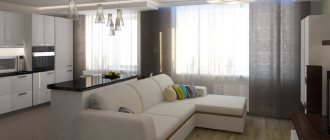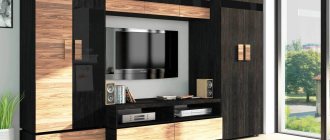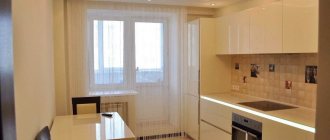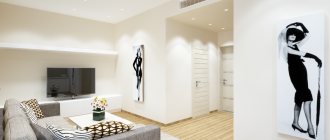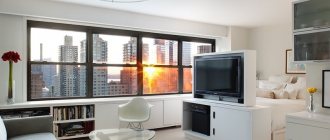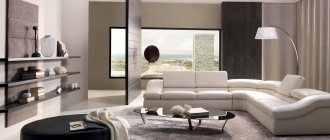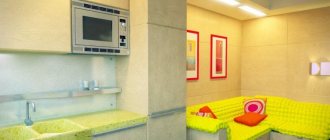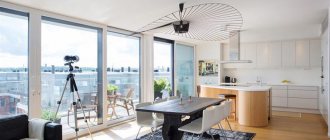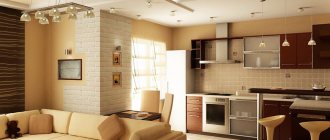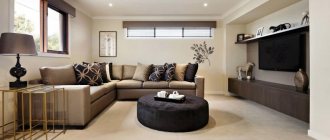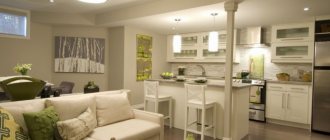When modern apartments are renovated, two rooms are often combined to expand the space. Among other questions, a dilemma arises about how to decorate the ceiling in the kitchen-living room in order to emphasize the features of the room and not overdo it. It all depends on the goal, budget and interior design.
The ceiling covering in the kitchen-living room should look attractive, be practical and durable
Ceiling design options in the kitchen-living room (photo selection)
If the owners decide to combine two different spaces, then they need to decide whether they will be one whole or should complement each other. This is fundamentally important, since with this decision we begin to think through the concept - one or two stylistics.
The design of the ceiling carries an important emotional load in the interior of the kitchen-living room
In the context of the design of the entire room, the design of the ceiling is also thought out, and the following factors should be taken into account:
- Dimensions. If the room is low and has a small area, then you should not choose a two-level option for finishing the upper surface; it hides excess space. It is not recommended to choose too dark tones. And in very spacious rooms you can use stucco to emphasize and create a somewhat pretentious atmosphere.
For a small room, suspended structures are contraindicated, but a ceiling with an illuminated niche will create the illusion of a high ceiling - Lighting. The kitchen area needs more light and preferably with LED lamps. The living area usually requires more comfort and dim lighting; solutions of variability are usually adopted.
- Invoices. Various materials on the ceiling in the kitchen-living room in interior design often look impressive and speak of an individual approach to design.
Polystyrene panels are a budget-friendly and very effective way to create a variety of textures on the ceiling surface
The style of one part of the room cannot be radically different; they must be consistent, even if the contrast method is used.
Plasterboard structures
Combining a living room and kitchen with high ceilings, most designers install multi-level plasterboard structures. From a design point of view, this solution is universal, although it requires quite a lot of time to implement: for this option you need to build a complex frame and finish it with plasterboard sheets.
This method is not used to create a single, even ceiling. But zoning of varying degrees is performed masterfully.
- Two-level - in the simplest case, a figure of the second level is formed above the kitchen area, and a figure of the first level is formed above the living room, since it has a large area. A more complex option involves creating several second-level figures, for example, a wide rectangular beam with built-in lamps that separates the kitchen from the living room, and second-level figures around the perimeter of each zone.
In the techno style, a combination of geometrically correct second-level figures or niches with the same clear outlines simultaneously emphasizes a single space and structures it to the proper extent. In this way, you can create smaller zones - above an armchair and a work table, for example, above a bar counter.
The configuration is possible and as curvilinear as desired: plasterboard is flexible and allows you to create the most complex shapes. This option is more suitable for various classical styles, as well as high-tech and fusion styles.
- If the height of the room allows, multi-level ceilings are installed - with three or even more height differences. This design can be extremely decorative and complex. It is the ability to form any volume with any configuration from plasterboard that makes it a favorite material for designers.
In addition, drywall can be painted, whitewashed, wallpapered, tiled, and even hand-painted.
Modern ceiling design
Often, architects deliberately create a layout with a combined kitchen to increase demand. This is a fashionable trend; many owners appreciate the advantages of this option. But figuring out how to make a ceiling is a task that people with innate good taste and professional designers can do. After all, more than one question is posed here:
- make the ceilings in the living room combined with the kitchen competently by modern standards;
- choose a single style or two;
- whether to divide the surface by structure, color.
One of the goals of modern ceiling design is to create comfort. If the owner feels good in such an atmosphere, the eye does not “stumble” on anything, this is one of the indicators of a successful project.
When choosing a design, it is not at all necessary to strictly follow one style direction. It’s better to take a couple of your favorites and select from them what you like
Living room plus kitchen: pros and cons
Quite often, such a solution is considered possible and successful when the kitchen and living room area is small. In practice, such aspirations are justified only in the case when the kitchen is rather nominal in nature and is reduced to a sink, microwave, refrigerator and coffee maker. In other cases, kitchen equipment and furniture immediately occupy most of the space, turning the room into a very modest dining room-kitchen.
If there is sufficient space, then combining the living room and kitchen into a studio is quite justified. The advantages of this solution can be considered:
- a large space with several windows creates a feeling of spaciousness, even in cases where the interior is decorated in classical styles and involves a large amount of furniture;
- the kitchen serves as a hearth or fireplace, which fully corresponds to the original classic purpose of the living room;
- the large area of the combined space, on the one hand, allows for more interesting design solutions, and on the other hand, allows you to effectively maintain the unity of style;
- integration allows you to solve the lighting problem much more effectively, without increasing the cost of the project. The ceiling in the living room and kitchen serves as the base for any kind of lamps and lighting;
- Very convenient for the housewife is the ability to quickly transfer dishes and remove dishes from the dining table. At the same time, people who dine retain the feeling of dining in the living room, in a beautiful hall, and not next to the stove.
The disadvantages of the solution are quite significant:
- Cooking is accompanied by evaporation of fat, water, the appearance of soot, solid hot particles, many odors, an increase in temperature and humidity. All this is unacceptable in the living room, and therefore the kitchen combined with the living room must be equipped with powerful ventilation and exhaust hood, and preferably an air purification system;
- cooking is accompanied by sounds. This problem is not being solved. The maximum that can be done is to use the most silent technology possible;
- Cleaning the kitchen should be done much more often: a dirty work table looks more than unsightly in the living room.
Options for finishing ceilings in the kitchen-living room
With ceilings in the living room combined with the kitchen (see photo), it is important not to make a mistake, otherwise the miscalculation will be double the size. Careful selection of materials is important so that the finishing emphasizes the advantages and decorates the room.
Textured wallpaper will hide minor defects in the ceiling covering
Tensioners
Stretch ceilings are a popular option with many variations of colors, shapes and structures. It is installed either as a single canvas over the entire space, or they try to combine it with drywall or other variations. Sometimes two different tension panels are used, harmoniously combined, but selected for a specific zone in space.
The stretch fabric can be matte or glossy, plain or patterned
From plasterboard
Beautiful lines are often created from this material and spot lighting is used to enhance the effect. This applies to the two-level option, but one layer is also used, especially if the surface of the original ceiling turned out to be problematic. Only in the case of very low walls should you carefully select such a finish.
You can make anything from plasterboard, in accordance with the design ideas of the owners of the kitchen-living room
Combination of plasterboard with suspended ceiling
This combination is especially popular among owners who want to make their kitchen-living room special and memorable. This ceiling option looks impressive when it creates the illusion of a floating element in the middle of the ceiling. You can use canvas with or without gloss, any pattern or structure.
Stylish combination of white plasterboard structures with mirror inserts made of stretched fabric
From other materials
Lovers of a loft or farm theme will like wooden coverings. It can be a ceiling design in the kitchen-living room as a decor on a putty surface or completely made of boards. Also, sometimes this surface is covered with wallpaper in the same color as the walls or another color.
Natural wood or its imitation is perfect for decorating the ceiling of a kitchen-living room in a modern style
Painting as an option for finishing the ceiling
One of the budget options is painting; it looks good if the surface itself is perfectly flat. Then you can choose an interesting shade and come up with a painting. Sometimes the ceiling is painted snow-white, and around the place where the chandelier should be, an image is drawn with thin gold lines and other techniques.
Painted ceilings are easy to clean from dust, but stains can only be removed by repainting.
Dropped ceilings
The design of all suspension systems involves a frame made of a metal profile of various types and suspensions with which it is attached to the base base. Its convenience lies in the ability to adjust the distance between the ceiling trim and the ceiling itself. In addition, in this way it is very convenient to equip any types of built-in and hidden lighting.
- A typical example of a suspended system is a cassette ceiling. Decorative tiles are laid on top of the frame and can be moved, removed or replaced at any time. Almost any material - from budget cellulose filling to designer glass with backlight.
The shape of the slab is always clearly geometric - square, rectangle or hexagon, but the sizes of the elements can be different. You can also combine pieces of different colors to create structure and separate the living room and kitchen. Despite the versatility of this solution, it is rarely used in apartments, since it fits very few common styles: modern, techno or constructivism.
Inserts made of colored glass and mirrors, even with a pattern, allow you to diversify the cassette ceiling. However, models with glass are noticeably heavier, more difficult to install and, of course, much more expensive.
- Another little-known design option is metal slats. Like any other hanging option, the system reduces the height of the room, and significantly - by at least 10 cm. The surface structure is clearly defined: long slats with dividing inserts, which is not to everyone’s taste. Another limitation is that the system assumes only a single space.
There are also significant advantages: metal slats are quite flexible and easily hold the most intricate shapes. Waves, cascades, relief protrusions - this way it’s easy to structure any space. It looks very impressive, as you can see by looking at the photo.
The slats are made of stainless steel and aluminum. In this case, the material can have its own color or be painted in the most exotic shades. You can change the texture - alternating polished and brushed metal creates a very unusual effect, however, it is this shine and brightness that is also a kind of limitation: the option is suitable for baroque, hi-tech, neo-baroque, art deco styles - that is, concepts that imply luxury.
Types of ceilings for the kitchen-living room
To combine, but leave the individuality of each zone, you can make everything out of plasterboard, but there will be one level on one side and two on the other.
- Single-level. A single-level ceiling allows you to avoid unnecessary issues with problematic original ceilings. It is easy to install, quite durable and looks neat. Plus, it is not difficult to fix if damage occurs.
A single-color ceiling on one level leaves the kitchen-living room space as it really is - Multi-level.
They give you the opportunity to “play” with lines, color and lighting. But there is one disadvantage, noticeable only in some cases, they reduce the height of the walls. But in most cases, such installation is a way to make your room stylish, thoughtful and comfortable. By placing surfaces at different levels, you can achieve the effect of expanding the space and increasing the height of the ceiling
Combination of plasterboard with suspended ceiling
This ceiling idea is interesting for decorating combined rooms. This approach will allow you to rationally zone the space. Note that such structures are durable. Moreover, if a situation arises when the fabric of the tension system deteriorates, it will have to be replaced. In this case, a combination of tension and suspension structures will make it possible to save on materials.
Application of plasterboard and PVC sheets
When creating combined structures, consider the following:
- The height of the tension system and the frame do not match. The canvas is always above the gypsum board.
- The fastening will be as strong and reliable as possible if the screws are adjacent to the drywall sheets and box profiles. Here you should take into account the fact that the screws extend approximately 25 mm beyond the plane of the PVC film.
- You can organize lighting in a kitchen with a living room using any available method. It is recommended to make technological holes in the drywall to insert spotlights into them.
Lighting example
Important! Lighting plays a significant role in the interior. This is done using LED strips. They are attached to the drywall after installing the tension system.
If you plan to install lighting devices in a hidden niche, make sure there is free space for it. The height of the niche is more than 100 mm, and the depth is less than 100 mm. The suspended ceiling itself is installed after the painting work is completed. When arranging large rooms, the system box is reinforced so that the stress that occurs on the frame does not damage the ceiling itself.
An example of a ceiling structure in a combined room
How to zone a space using ceilings in the kitchen-living room: interesting ideas (selection of photos)
A suspended ceiling is often used for precisely this purpose; it can play a role in zoning. Considering that many owners prefer a two-level ceiling, this can be done with the help of lighting, creating the effect of a floating element in the middle.
With the help of spectacular lighting of the ceiling structure, you can highlight the dining area of the kitchen-living room
Also, zoning using the ceiling is performed:
- using different textures;
- creating different levels - two or more;
- They use more than one material, etc.
The bright red color of the plasterboard structure acts both as an accent and as a space divider
Combining 2 or more finishes can have a positive effect on the overall interior, but it is important not to overdo it with colors.
Necessary Requirements
The ceiling in the kitchen is made of a variety of materials. However, one should sensibly evaluate the financial capabilities, the requirements for the operation of a particular material, and the frequency of cooking. Culinary processing is accompanied by strong changes in temperature and humidity, the appearance of steam, evaporation of fat, soot, and the action of color pigments. In addition, it should be taken into account that these factors will affect not only the area of the work area, but also the decoration of the living room.
Materials for ceiling decoration must meet the following mandatory requirements:
- resistance to moisture - both water and evaporation. Otherwise, repairs, and the entire combined kitchen-dining room will have to be carried out much more often;
- resistance to pollution. Even with a powerful hood, it is impossible to completely protect the walls and ceiling from splashes of grease, water, food particles, and the like. Accordingly, finishing materials should be low-porous and not prone to absorption;
- ease of cleaning – the dirt-repellent effect alone will not ensure cleanliness. Finishing materials should easily tolerate cleaning with warm and hot water, household chemicals, and, if necessary, using abrasive materials;
- One of the very useful properties of kitchen materials is the ability not to absorb odors . When combining the kitchen and living room, the recommendation turns into a mandatory requirement;
- repairability - the ceiling above the kitchen area will in any case require repairs earlier than the ceiling in the living room. Accordingly, it should be designed in such a way that, if necessary, repairs can be carried out only in certain areas.
Quite a few materials meet these requirements. In practice, the choice takes into account only the most important factors, as well as the financial capabilities of the home owner.
Pros and cons of suspended ceilings
The advantages of suspended ceilings quantitatively outweigh the disadvantages; they include the following:
- Long term.
- They are safe and environmentally friendly.
- Saves from dampness.
- They have average prices.
- It is easy to care for.
- Big choice.
- They hide engineering structures if they run along the ceiling.
The main advantage of a stretch ceiling is its resistance to leaks and humidity fluctuations
At the same time, there are disadvantages to this option:
- Although it can be quickly installed, it is difficult to do on your own.
- The seams, especially if not done by a professional, may be too noticeable.
- The smell lasts for several days, then becomes less noticeable and disappears completely.
The tension fabric is quite easy to damage with a sharp object.
If there are allergy sufferers in the house, you will also have to carefully study the composition of the material used for suspended ceilings.
Kitchen combined with living room and tension structures in it
When choosing a suspended ceiling for such a room, first determine the following:
- room style;
- ceiling shape;
- design complexity;
- type of canvas (texture).
Complex ceiling structure
Advice. If the kitchen area is much smaller than the living room, use dark colors. However, you cannot make such a decision if it is larger than the living room. In such a situation, even well-chosen lighting will not be able to correct the failure.
After this, you can start creating the design. Buy only high-quality canvas. The ceiling itself can be glossy, satin or matte. With any choice, it is important to use light sources wisely. Modern and classic styles use decor using photos on the ceiling. The main thing to do is to achieve uniformity of the image. As an option, you can decorate the ceiling with frescoes and paintings.
An example of using a fresco on a ceiling canvas
A competent choice of the shape of the tensile structure hides flaws in the floor slab, power cables, ventilation shaft openings, poorly executed niches, bevels, and cracks in the slab.
A great idea is to decorate the ceiling with lighting located behind the canvas. If you use photo printing on film, you can create a real starry sky in your kitchen.
Starry sky design
Color for decorating the ceiling in the kitchen-living room
The most common colors for ceilings are shades of white, followed by pastel options. Combinations with dark and black colors are considered a special style. But many owners decide to make bright decisions as an accent or addition to the interior.
A white ceiling is always relevant for small rooms
It should be remembered that each shade has its own effect on the psyche and mood of a person. Creating a specific and special atmosphere is the task of the designers. Choosing a boring palette can cause depression, and intrusive colors in large quantities can irritate and affect feelings of anxiety.
Sky blue panels combined with white beams create a pleasant nautical ambience
Too many dark solutions without proper lighting often become a bad option. And illiterately selected light shades carry a feeling of dullness and emptiness. Therefore, it is important to take into account the overall appearance of the room when determining the color of the ceiling.
Haute cuisine is appropriate in…
- in small apartments - to increase the storage area of a linear kitchen;
- houses with low ceilings - to extend the room upward;
- studio apartments - to reduce the area occupied by the set.
Gap between cabinets and ceiling
But it’s still worth admitting that a small gap between the cabinets and the ceiling looks quite ridiculous - like a flaw or an omission.
Therefore, although this is a matter of taste, the rule is formulated by itself: either the distance should be decent, or there should be none at all.
An example of an inappropriate gap
Pros of a kitchen under the ceiling
- With this layout option, the storage system increases almost 3 times and dust does not accumulate in hard-to-reach places. Let's try to understand the pros and cons of such a set in your kitchen?
- The advantage of using tall cabinets in the kitchen is a visual increase in space. Elongated cabinets, like vertical stripes on the walls of the kitchen, increase volume and height, create the impression of solidity, the facades shift into perspective, dissolving into the plane of the walls.
- No clutter in the kitchen. The more space you have to store kitchen utensils, the less clutter you will have on your table and work surface.
Ceiling lighting design in the kitchen-living room (photo selection)
The combination of two rooms leads to the desire to divide them into thematic spaces. This can also be done with ceiling lighting. For example, installing spot lighting elements around the perimeter will definitely fulfill its function. Shades of emanating light in one and the other part of the room can also help.
A pendant lamp above the table or in the center of the room provides general lighting for the kitchen-living room
Spotlights are used to illuminate functional areas in accordance with a pre-designed scheme
So, the ceiling in the kitchen-living room is an important part of the interior, capable of transforming the space or ruining it if lines, materials, and colors are used incorrectly. Before you settle on a specific choice, you should take into account all the nuances so as not to pay twice later.
Color
The dimensions of the room and its side will help you decide what the ceiling will be like. A kitchen-living room with windows facing south will look advantageous with a cold-colored ceiling. Blue, blue, purple or green will make the room cooler and visually raise the ceiling. On a hot, sunny day it is especially pleasant to be in such a room.
The purple ceiling enlivens the room and gives a good mood Source stroy-podskazka.ru
Warm colors are suitable for a kitchen-living room with a northern location: yellow, orange, pink, red. Warm shades will add warmth and comfort to the room. Soft, sunlight will dissipate, creating a romantic atmosphere. You will want to spend more time in such a room. The kitchen-living room will become your favorite room in the house. Warm colors work best in a room with high ceilings. Rich, warm shades slightly reduce the height of the room.
In small rooms, it is advisable to choose a light color for the ceiling surface. Dark - will decorate a large apartment. Black, gray, brown will add style, uniqueness and rigor to the room. Dark ceilings require good lighting. If there is little light in the room, the ceiling will look gloomy.
A black ceiling in the kitchen requires much more lamps than a snow-white guest area Source design-homes.ru
The color of the ceiling should be combined with the overall scheme of the room and interior items. You can choose a shade close to the tone of the walls, furniture, and textiles. If the room is bright, it is better to choose a solid, pastel shade. A light ceiling will soften bright colors and add harmony to the room. White, beige, pearl gray are universal shades that will suit any room.
The ceiling in the living room kitchen, decorated in several colors, divides the room into zones. In the kitchen, a shade close to the façade of the furniture will suit; in the guest area, a color similar to the upholstery of the sofa. You can use two similar tones, close in saturation and brightness. One color of the ceiling in two zones will make the room a single whole.
The cool shade highlights the kitchen, the light tone of the living room ceiling adds coziness Source design-homes.ru
If you want to make a bright ceiling, you can use a combination of two colors: a calm, pastel shade and any rich one. The design is suitable for multi-level plasterboard structures, stretch ceilings with photo printing, and artistic painting. The combination of more than 3 bright colors on the ceiling looks provocative. A ceiling that is too contrasting will put pressure on the psyche and make the room aggressive.
The combination of white, beige, and walnut looks good in a classic kitchen-living room Source akuhnja.com
Photos of ceilings in kitchens and living rooms
Upper cabinets in two rows
Two-tier - a classic option with two rows. To achieve harmony, order furniture of the same width.
Zoning with colors and materials
How to divide a kitchen if every square centimeter counts? You can try to make do with colors and materials.
To begin with, it’s worth experimenting with standard color contrasts. For example, the kitchen is dark and the living room is light. Similarly, you can use different styles.
The kitchen can be decorated in a loft style, and the living room can be decorated in minimalism.
Textural differences are even easier to implement.
You can use any decorative elements, for example, flooring. In the hall you can make the floor from parquet or laminate, when in the kitchen tiles or linoleum would be more convenient.
If you are planning a hidden kitchen in the living room, why not try to design the unit in a sharply contrasting style? If the furniture is made of chipboard everywhere and the furniture is made of wood, you will get an interesting, dissonant, transitional interior.
Zoning methods
The most difficult part of zoning the kitchen and living room is to delimit the two spaces so that they do not interfere with each other. In this case, you need to take into account the specifics of the kitchen work area when choosing materials and finishes. And at the same time it is convenient to place not only the set, but also the entire work triangle with a sink, stove and refrigerator.
Static partitions
If you don’t like continuous combined spaces, full-fledged static partitions will suit you. A lightweight frame or plasterboard structure will replace entire brick or block masonry. Thermal and sound insulation without additional layers of mineral wool will be lower, but you will save space.
In spacious modern living rooms, static glass partitions look interesting. Moreover, the glass is not necessarily transparent: it can be frosted, tinted, or with patterns. Pay attention to designs made from glass block cubes: they are larger, but also more original. Wood, concrete, remains of brick and any other materials are also suitable for partitions.
To zone kitchen-living rooms, low partitions are often used - at the level of the countertop or bar counter. This is how you can use a ready-made structure and do without unnecessary furniture. And if you leave niches at the bottom, they can easily replace several wall shelves or a small rack.
An elegant technique is arches of any size and shape, from classic to wide and barely outlined. Rectangular or rounded arches are an eternal classic, and round, trapezoidal or any other curly arches are good in creative designer interiors. Niches, lighting, decorative cutouts or inserts are just as well built into them.
Screens and movable partitions
If there is not enough space in your kitchen-living room or you simply do not want to clutter up the space unnecessarily, use mobile partitions. They can be placed as needed to separate a work area, a guest area or a desk.
Screens and partitions can be folding, retractable and sliding, completely closed or translucent. These include impressive wooden structures, tempered glass, and airy openwork classic screens.
The simplest option is a durable folding frame and fabric or textile filling. For example, such partitions made of bamboo or dark wood with white thin fabric are popular in Japanese and Mediterranean interiors.
Curly carved models with gilding, patina and forged fittings will harmoniously fit into the classics. In rustic interiors, plywood or chipboard painted in pastel colors with floral patterns or decoupage are in use.
Podium
A good alternative to vertical partitions is multi-level horizontal structures. In particular, these are podiums on which you can place both an area with a sofa and a kitchen corner. They can even replace a sofa with armchairs if you make it higher and add soft decorative pillows.
A low podium will smooth out differences between floor coverings well if you are laying tiles in the kitchen and laminate in the living room. A slight rise will clearly emphasize the demarcation without any partitions. The rounded design looks interesting, but it is more difficult to do in practice.
High podiums have another significant advantage: boxes and drawers for storing things can be built in there. A durable wooden frame is covered with plywood and reinforced, depending on its purpose. On a small high podium you can create an elegant green corner.
Curtains and drapes
Instead of partitions and screens, textiles can be used to separate the kitchen from the living room, but there are nuances here. This option will fit well into Provence or classic style, but is rarely appropriate in minimalism or modern. You will have to carefully select the fabric so that it does not accumulate dust and does not absorb odors from the kitchen.
Curtain dividers are still hung on a curtain rod or string, which can be hidden in a multi-level plasterboard ceiling. If you want to separate the seating area or work desk, you can use thicker fabrics. But near the kitchen area they are much less practical and sometimes unsafe.
An interesting technique for classic and romantic interiors is to enclose a sofa or podium with pillows with a canopy. The main thing is to choose a design that you can easily disassemble regularly for cleaning. And keep in mind that this option is for spacious studios, because it is quite bulky.
For zoning, choose curtains that will match the curtains on the windows. They do not have to be identical, but it is desirable that the textures and colors echo each other. But the configuration is no longer so important: for example, there may be roller blinds on the window, and ordinary curtains with tiebacks in the room. Curtains for zoning are not necessarily fabric. In eclectic styles, boho, ethnic and other creative styles, handmade work is actively used. For example, wide dense fringe, threads of beads, all kinds of pendants.
Furniture
If you don’t want to build extra partitions and hang curtains, use furniture for zoning. The simplest option for a kitchen with a living room is an L-shaped set, positioned so as to separate the work area. But when installing the sink and stove, do not forget about splashes of water and fat during cooking.
Another classic option for spacious studios is to use a bar counter to separate it. It will complement the set on the one hand, and on the other hand it will brighten up family holidays and friendly parties. If you don't need a large dining table, a counter with several stools will replace that too.
The spacious living room also includes a full dining area with a table and chairs. To further emphasize the division, hang several individual lights above it. And in small studios, pay attention to folding tables that can be removed if necessary, as well as a folding partition.
An alternative option is to select not a kitchen area, but a recreation area. Here the classic island layout will come to your aid, when furniture is arranged not along the perimeter, but according to function. Divide the areas with a wide, but not too massive sofa with a couple of armchairs and a coffee table.
A good option for zoning is light through shelving, which will replace massive shelves and pencil cases. You can store books and favorite collections in them, as well as kitchen utensils, jars of cereals and spices, or beautiful dishes.
Design of a kitchen-living room in a modern style (65 photos)
